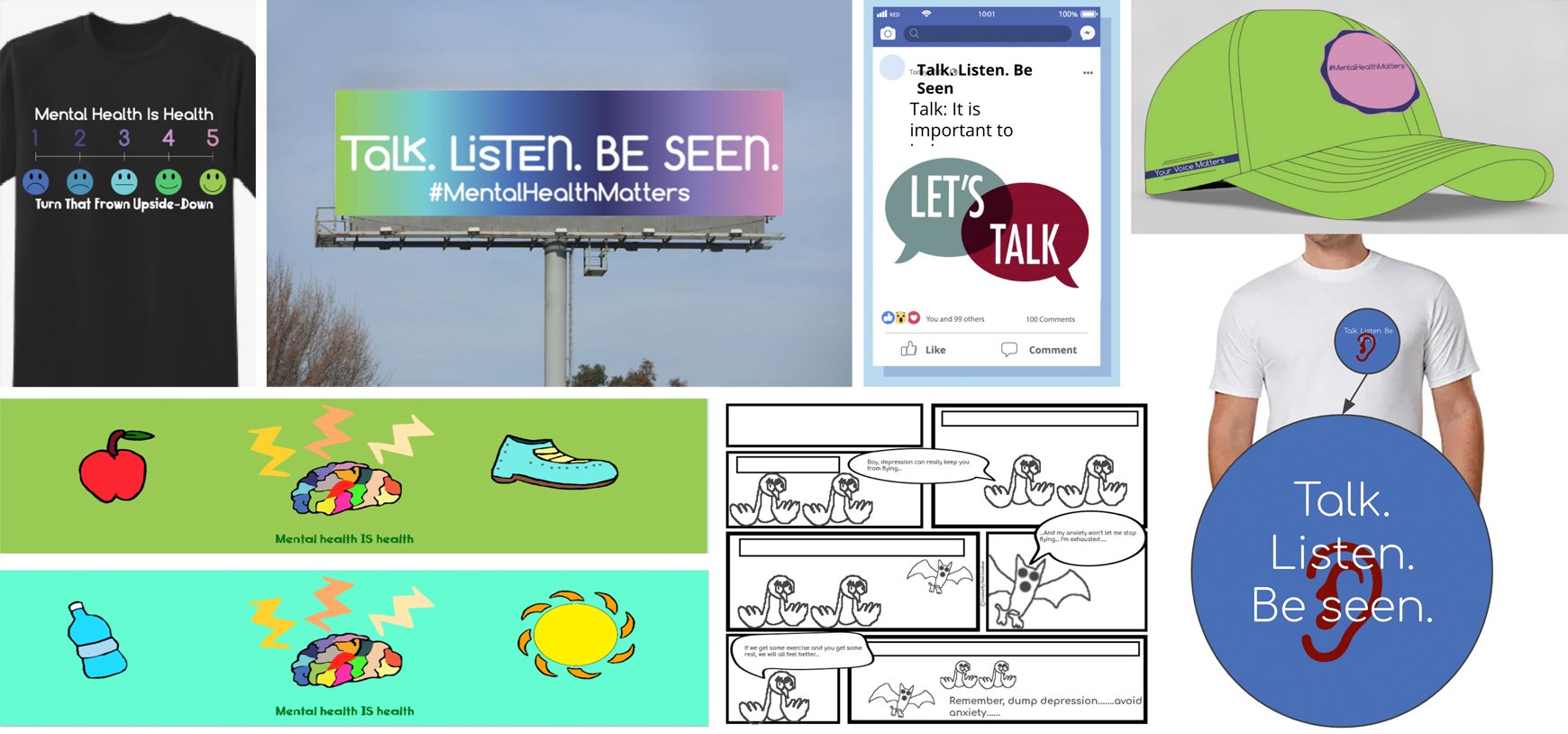Mental Health and Autism…Or Is It Just Being Human?
The following post has been co-authored by Amy Mason, Director of Integrated Learning and Matt Juzenas
Over the past two months, our Digital Academy (DA) students completed a Design Thinking sprint creating a social awareness campaign. The team explored multiple topics and issues including LGTBQ+ rights, bullying, autism rights, and gender equality before choosing to create their campaign around the issue of Mental Health Awareness.
In this post, Matt Juzenas, will share some of the work that our DA students created and how their approach changed many of our perceptions around how autistic people display empathy. Amy Mason, Director of Integrated Learning, will also share her experience as an occupational therapist in schools and how she often saw “typical” human challenges being blamed on a student’s disability.
Mental Health Awareness: Talk. Listen. Be Seen.
The DA team chose the topic of mental health because it is an issue that many of them have experienced firsthand. Throughout the sprint, they showed great empathy for others in their lives who struggle with their own mental health. The team focused their awareness campaign on four areas of mental health: depression, anxiety, self-esteem, and self-care.
As we developed our campaign, the students zeroed in on their message on the importance of not only sharing their stories with others but to also be there as supportive listeners for those who are struggling with their own mental health. By sharing our stories, we can remove the stigma around mental health and make the invisible ailments visible. And so the students developed the tagline, “Talk. Listen. Be Seen.” The secondary messages included, “Because you matter.”, “Mental health is health.”, and “Your voice matters.”
As one student shared, “mental health challenges are no different than a broken arm…the hurt is just as real.”
DA Student, Alec’s Bus Stop Poster and Illustration “I’m Fine” highlights that the pain caused by mental health struggles is just as real as physical pain.
Other projects included social media posts, video storyboards, billboards, social stories, clothing apparel, comic strips, buttons, and posters:
DA students, Ben, Garrett, Jake, James, Mackenzie, and Trinity’s designs for their mental health awareness campaign, “Talk. Listen. Be Seen.”
The students worked both collaboratively and independently to create these concepts that spoke to a targeted audience they selected with personas they created so that they would have a clear idea of who they were speaking to. They collaborated on developing the complete branding for this campaign from messaging to color schemes to typography.
Perception shift: empathy and autism
We start each session at Islands of Brilliance with a question of the day. On day two of our sprint, we asked, “If you could fix one problem in this world with the snap of your fingers…what would it be?” Maybe you’d expect to hear answers that are trivial or only relevant to the individual students. After all, a big perception of the autistic community is that they lack empathy for or awareness of others, right? Our DA students responded that the issues they would fix were racial inequality, racism, depression and anxiety, gender inequality, and doubling the number of resources that people need. I’ll be honest, these were not the types of answers we were expecting to hear!
Design Thinking is a problem-solving process rooted in empathy. Our students have used this process to create a better dental experience for autistic patients, improve the user experience for job seekers with disabilities, and most recently create their mental health awareness campaign. The design thinking process begins with understanding and empathizing with the end-user. In working together as a team, they have also shown amazing empathy for each other.
Towards the beginning of this development sprint, the students took a moment to share their expectations of each other and what their team can expect from them. They then created a team mission statement and each team member signed it.
A slide from our collaborative workspace where our DA students shared expectations of each other for this development sprint.
Our students expected a “Judgment free zone” where they would have “Openness of other’s lifestyles.” They expected help from their teammates and in turn wanted “to make sure that everyone’s okay and if they need help.” They pledged to each other that they can expect peers who will “always try to understand your perspective,” “listen with an open mind and heart,” and “be supportive.”
This statement really sums up the empathy our students have shown for each other, “I will always care about you guys because you all help and support me!”
Just as we start each session with a question of the day, we often ask the students to reflect on what they have learned throughout their experience in each design sprint. On one of the last days, we asked, “We have spent the past five weeks talking about mental health awareness. What is something you learned or realized about yourself during this process?” And once again, the amount of empathy and self-awareness demonstrated was beautiful. One student wrote, “I learned that it's okay to talk about your mental health, even during the pandemic. And don't be afraid to speak up about your mental health as well!” Another answered, “That everyone deals with mental health issues in some shape or form and I need to remember that while interacting with people daily.” And finally, “There’s a lot more about dealing with depression and anxiety than I thought there would be. I need to create strategies to strengthen my own well being.”
It might not just be an autism thing, it might be a human thing.
Today, as we are still in the midst of a global health pandemic, mental health struggles are at an all-time high. One of the silver lining outcomes of this is that as a society we are also talking about mental health more openly than ever. Throughout our development sprint, the students often spoke of the COVID-19 pandemic and how it has affected their own mental health.
Our DA students range in age from 14 to young adult. Looking at mental health statistics (pre-pandemic) for this age group, the CDC finds that depression, anxiety, and behavior problems often co-exist:
Having another disorder is most common in children with depression: about 3 in 4 children aged 3-17 years with depression also have anxiety (73.8%) and almost 1 in 2 have behavior problems (47.2%).
For children aged 3-17 years with anxiety, more than 1 in 3 also have behavior problems (37.9%) and about 1 in 3 also have depression (32.3%).
For children aged 3-17 years with behavior problems, more than 1 in 3 also have anxiety (36.6%) and about 1 in 5 also have depression (20.3%).
These figures do not distinguish the neurodivergent community from the neurotypical community. Depression and anxiety are universal, human experiences, increasingly experienced and diagnosed in the teenage years. In a study by the National Center for Children in Poverty, we discover that “Between 20% and 30% of adolescents have one major depressive episode before they reach adulthood. For a quarter of individuals with mood disorders like depression, these first emerge during adolescence.”
As a former school-based occupational therapist working on IEP teams, Amy Mason often heard teams discuss issues around student behavior through the lens of the identified disability. This was very often the case for autistic students. For example, a student with autism who argued with his educational assistant about putting away his favorite graphic novel to focus on a science activity was called “rigid” or it was determined that he “had trouble with transitions.” In these instances, she was usually able to spot a neurotypical student without an identified disability (and who did not have an educational assistant nearby) in the same class who hung on to her favorite book in a more discrete way, reading a few pages when the teacher was helping a group of students across the room. Same issue, different behavior and outcome.
Most children - and people - would much rather continue doing the thing they love doing rather than switch to the thing they’re not crazy about doing or maybe aren’t very good at doing. The autistic child in a classroom usually experiences increased demands from the environment that leaves empowerment and choice at the door, impeding his ability to learn naturally through social consequences.
She would often call these situations out for parents, helping them find the line between their child’s disability and their child’s development as a human. “Think about your own ability to transition,” she would say, “and reflect on strategies you use to move between preferred and non-preferred activities. For example, when you are enjoying some quiet time to yourself, but realize that it’s time to do a household chore, what do you do to ease that transition?”
Helping people reflect on their own situations improves their empathy toward their child’s disability, as well as helps them understand the impact of the natural developmental things that are also going on with their child.
Additionally, blaming it on autism is not very helpful since the undesired behavior will remain without taking the time to reflect and employ a proactive exploration of strategies. Give your student a chance to work with you (or his teacher, therapist, counselor, case manager, etc.) to figure out the best way to navigate these difficult moments by helping him understand himself, the environmental expectations, and do your best to understand what he is experiencing in those moments.
Whether it is a specific social or behavior challenge, non-compliance and testing the boundaries of independence, or even struggles with mental health there are certainly many aspects that can be amplified by the layer that your child’s autism brings. The bottom line is that many things that neurotypical children experience are often the same things that an autistic child experiences, but the child with autism will likely need assistance to manage them due to the additional expectations and layers of those experiences.
Our students at Islands of Brilliance consistently amaze us, not only with their fearless creativity, but also with their beautiful displays of humanity. The connections they make and the care they show for each other defy stereotypes and perceptions of the autistic community. It can be easy to use autism as our go to explanation for any challenge our children face. But if we look past the autism, our children face many challenges that are actually just a part of the beautiful experience of being human.





